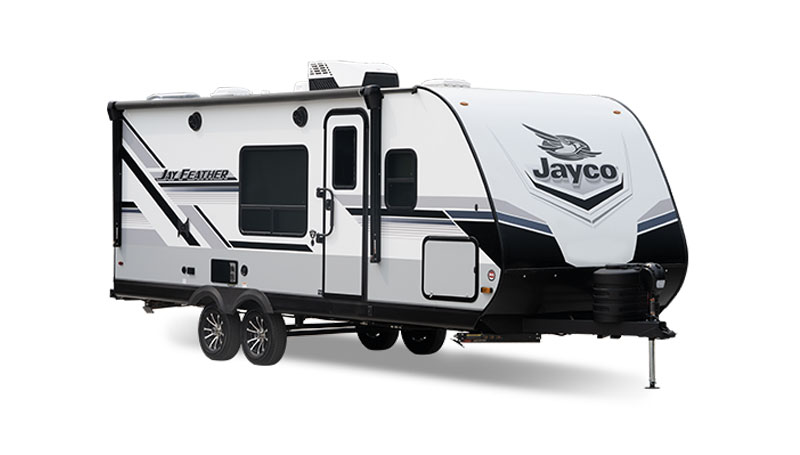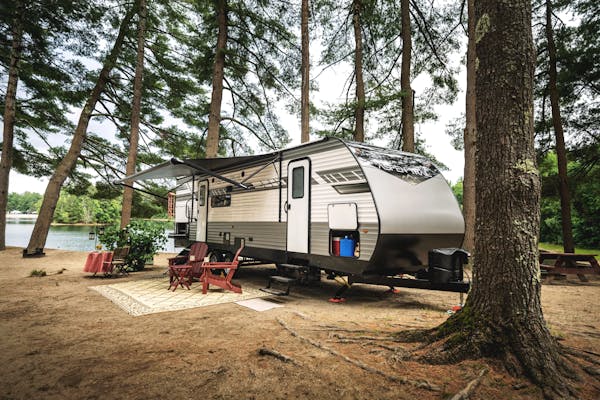Slow Is Smooth And Smooth Is Fast
Our number one tip will always be to take it slow. Don’t feel like you need to rush into your space, as this is when accidents are more likely to occur. Even if you have an audience of fellow RVers watching you, or a line of cars behind you, take your time and take it slow. And just remember that everyone was new at backing up at one point, so don’t feel embarrassed or intimidated.
Check Your Campsite For Debris
Before you pull into your campsite or parking space, always check the site for debris. This could include low-hanging branches, large rocks, soft soil, or potholes. Be aware of anything that could puncture your tires, or scratch the top or sides of your RV. Try to be flexible. You may need to move an object or re-route your path to avoid hitting something.
Use Hand Signals And Appropriate Terms
If you are traveling in a pair or with multiple people, assign one person to be the “spotter” and another person to be the “driver.” The spotter will get out and safely stand behind the RV to help guide it into place. The driver will do the actual backing up and controlling of the RV.
The spotter should use appropriate hand signals to help guide the driver—pointing left to go left, pointing right to go right, and both hands up to indicate stopping. You can also use cell phones or walkie talkies for verbal communication. If you choose to verbally communicate commands, try to use terms like driver’s side or passenger’s side to help clarify to the driver which way you want the RV to go.
Pro Tip: If you are towing a travel trailer by yourself, don’t be afraid to ask a neighbor or nearby RVer to help you back up and act as your spotter. If you’re alone and no one is around to help, you can always periodically get out of your tow vehicle to check your progress.
Make Sure Your Tow Vehicle Is Clear
Making sure your campsite is clear of any obstacles is critical for backing up, but you also need to be mindful of what’s in front of you. The driver should always keep an eye on the front of the tow vehicle as they back up to ensure nothing will limit or obstruct their ability to turn.
Pay Attention To Your Spotter
As the driver, you should always pay attention to your spotter and follow the commands they provide. Even if you think you are clear, there may be things you can’t see or a blind spot you’re unaware of that your spotter can help you maneuver around. Have your spotter stand at a slight angle behind the travel trailer so you can see them in your rearview mirror. If you cannot see your spotter, then you won’t be able to see any of their commands, so make sure you maintain spotter visibility at all times.
Use Extended Mirrors
If possible, get some extended side view mirrors for your tow vehicle. These are often called tow mirrors, and can be easily installed to your existing side view mirrors. Having extended mirrors allows the driver to see wider and farther back, and provides more complete travel trailer and tire visibility and when backing up.
Place Your Hands At The Bottom Of The Steering Wheel
One of the most common issues when backing up a travel trailer is steering too much, or oversteering. A great tip to help avoid oversteering is to keep your hands at the bottom of the steering wheel, as opposed to the top or sides. With your hands at the bottom of the steering wheel, when you turn right, the back of your travel trailer will also turn right. And when you turn left, the back of your travel trailer will also turn left. This hand placement makes it much easier to match hand placement with turning direction. Keep in mind that as you back up, your tow vehicle and your travel trailer will start to form a V-shape. The farther you turn your steering wheel, the sharper that V-shape will become, so try to keep your turns small and adjust as needed.
Remove Your Sway Control Bar
If you have one, it’s always a good idea to remove your sway control bar before you start backing up. Sway bars can limit your turning radius and, sometimes, if you need to make a quick adjustment or tight turn, the sway bar can damage your hitch and tow vehicle frame. It takes just a few seconds to remove the sway bar, and it’ll give you a lot more flexibility and peace of mind.
Practice, Practice, Practice
We can’t say this enough—practice makes perfect. The more you practice, the more comfortable you will feel handling your travel trailer. Head to a parking lot or open space and practice turning around and backing up. You can even lay out some cones or blocks to create a “campsite outline” to help guide you. This is also a good opportunity to practice communication with your spotter, or even switch roles so you both can practice being the driver and the spotter.
Tires Should Be Clear Of The Site Before Turning
When you go to back into a campsite or parking space, your RV tires should go past, or clear, the entrance to the site before you start backing up. This will give you more room to back up and allow enough space to get your RV straightened out. This is especially important if the entrance to your site is narrow. You may have to do this a few times before you’re able to align your travel trailer, and that’s okay. Just remember to take it slow and listen to your spotter’s directions.
Always Communicate
Our last tip is to over communicate. The driver and spotter should be in constant communication throughout the entire back up process, whether that be through hand signals or verbal communication over walkie talkies. As the driver, ask for clarification if you’re unsure and have your spotter repeat something if you think you didn’t hear it correctly. As the spotter, be as vocal as possible. Even if the driver is doing a great job and everything looks clear and straight, you should still offer encouragement and advise the driver to keep going.







